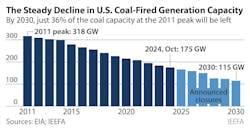U.S. Coal Capacity Expected to Continue Decline Amid Rising Demand for Cleaner Energy Sources
The outlook for coal in the U.S. energy mix remains on a steady downward trajectory, according to recent data. The Institute for Energy Economics and Financial Analysis (IEEFA) reports that utilities across the country plan to retire or convert 68,789 megawatts (MW) of coal-fired capacity from 2025 to 2030. This number nearly doubles the 36,425 MW reported by the U.S. Energy Information Administration (EIA) in September, due to the EIA’s exclusion of coal-to-gas conversions, which IEEFA counts as retirements once coal combustion ends at those facilities.
Since coal generation peaked in 2011, utilities have consistently moved toward lower-carbon sources, with an average annual reduction of around 10,000 MW of coal capacity. IEEFA’s latest projections indicate that operating coal capacity could decline to approximately 115,000 MW by 2030, representing a 63.8% reduction from its peak level of 317,600 MW. Beyond 2030, the outlook suggests continued reductions, with 33.7% of the remaining coal capacity post-2030 already scheduled for retirement by 2040.
Several factors are cited in this trend. Coal plants have generally aged, with more than 8,100 MW expected to be at least 60 years old by 2030. Additionally, coal plants’ capacity factor—indicating operational efficiency—has steadily declined, reaching an annual low of 42.1% in 2023, despite fewer total plants operating. This trend has implications for the economic feasibility of coal, as fixed costs are spread over fewer megawatt-hours produced.
According to IEEFA, the ongoing expansion of solar, wind, and battery storage, combined with regulatory shifts, further suggests coal’s role in the U.S. generation mix will continue to shrink. EIA's Short-Term Energy Outlook forecasts coal's generation market share to fall close to 10% by April 2025, down significantly from 20% in 2020.
Though the U.S. transition away from coal is slower than in countries like the United Kingdom, where coal has been entirely phased out, the shift toward cleaner energy sources is continuing in response to economic and technological developments in the energy sector.
